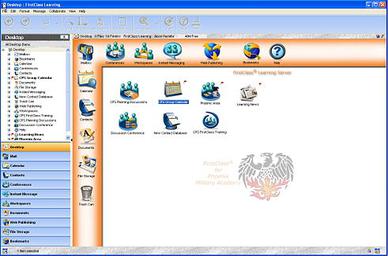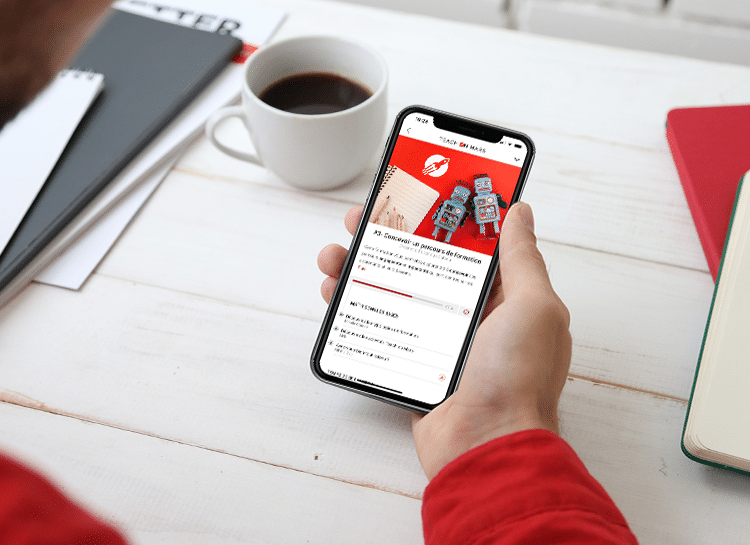All there is to know about MOBILE LEARNING
The essential guide to in-company mobile learning
Summary
Mobile learning has revolutionised the world of training.
Learning anywhere, anytime and using any device are the watchwords of this new approach, which is rewriting the rules of knowledge transmission.
But what is it all really about? How is mlearning used in a professional setting? What educational tools does it use? How can it help companies to develop a real culture of learning?
Here is all you need to know about mobile learning, the essential training tool.
1. A brief history of mobile learning
Digital learning platforms: from in-company training management to the learning experience
A screenshot of FirstClass, the first LMS, developed in 1990 by SoftArc
With the advent of the internet in the 1990s, the concept of e-learning was born. Very early on, the precursors of online learning recognised the tremendous potential of digital tools for exchanging and transmitting knowledge. E-learning gave rise to the very first LMS (Learning Management Systems).
These online training platforms revolutionised the management of learning, by enabling courses to be managed and organised optimally. From monitoring learners to disseminating educational content and customising courses, training had entered a new era.
In the 2010s, digital learning made spectacular headway, with the invention of LXPs (Learning Experience Platforms) and LEPs (Learning Engagement Platforms). These new generation, e-learning platforms were game-changers as they placed the digital learning experience centre stage, pushing training customisation even further.
1990 saw the appearance of the first LMS platform, created by SoftArc on the Macintosh platform.
The advent of mobile learning
Where LMS platforms concentrate primarily on managing training, LXPs were designed to optimise the learning experience. To this end, they take full advantage of the analysis of user data to recommend activities and content to each learner, matching their profile and needs.
The profile of each employee is carefully analysed: their position, career prospects and skills. Their interactions with the LXP platform are also examined, as well as exchanges with other learners and the most consulted content. Finally, results obtained from completed training modules enable the next pieces of content to be adapted.
These changes are attributable in particular to the need to improve the profitability of training, which has always been a substantial cost centre. The stronger the engagement of learners, the more tangible results are visible within the company and the higher the return on investment. By focusing on users, LXPs have brought about a significant increase in learner engagement compared to LMSs.
The arrival of smartphones revolutionised the world of training once again, with the advent of the first mobile first LXPs, including Teach on Mars. These platforms differ from traditional LMSs and LXPs due to their availability, because they are constantly within learners’ reach.
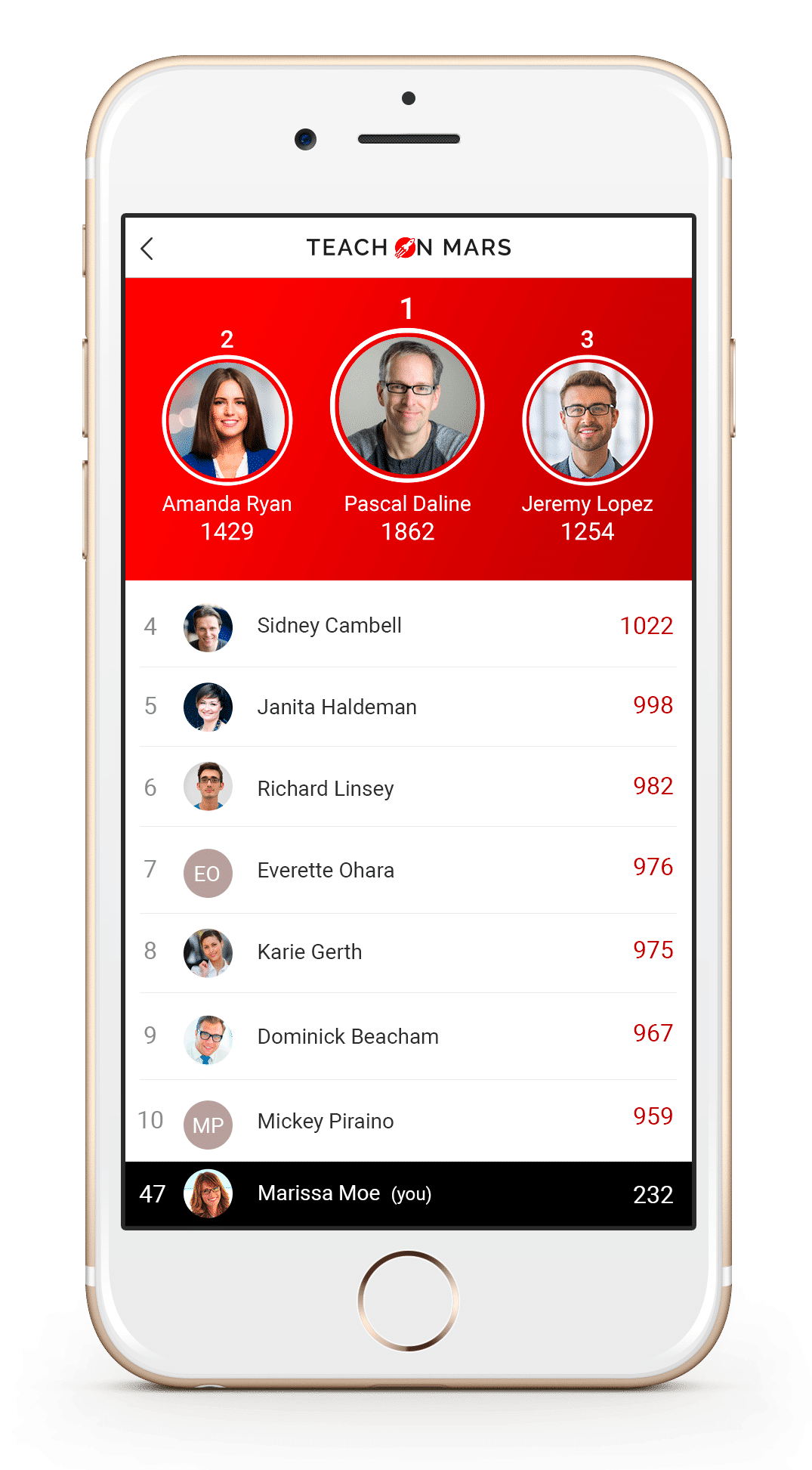
Capable of handling all of the complexity associated with teaching systems and resources, of engineering courses, assisting with their deployment, management and monitoring, mobile first platforms also stand out for their engagement levers which draw inspiration from mobile applications. These include micro-learning, gamification and social learning, with news feeds and discussion groups.
We’ve therefore come a long way since the era of 90’s training management software. LMSs have gradually integrated LCMS (Learning Content Management Systems), giving precedence to training content and customisation. LXPs brought with them brand new ways of learning, harnessing the most innovative technologies.
Mobile learning pursued this trend, enabling people to learn wherever, whenever and from any mobile device: smartphone, tablet, laptop, etc. Mobile first platforms (LXP/LMS) also radically transformed the educational approach of online training, by offering a wide variety of content, ranging from videos to quizzes, to positioning and self-assessment questionnaires.
ATAWAD: a key concept of mobile learning
ATAWAD (AnyTime, AnyWhere, Any Device) is central to the new approach to training mobile learning offers; providing maximum freedom and flexibility to users. It selects courses which can be done anytime, anywhere and on any device.
Mlearning platforms are more than simple LMSs or LXPs, whose design seems to have been adapted for mobile applications. They feature cutting-edge mobile learning technologies, based on the specific characteristics of smartphones.
2. The advantages and disadvantages of mobile learning
The advantages of mobile learning
Enlivens training courses and complements them with classroom learning, consistent with the principles of blended learning.
Enables learners to train independently, placing emphasis on self-learning and self-assessment.
Develops recall and increases the effectiveness of training thanks to innovative teaching methods which include micro-learning, gamification, video learning, etc.
Encourages collaborative learning with its peer-to-peer and social learning features.
The disadvantages of mobile learning
Short formats and fun pedagogical tools (such as serious games) are more appropriate for discovery and engagement than for in-depth training.
May harm learners’ concentration, as smartphones can lead to distraction.
May result in an infringement on private life.
3. PRACTICAL EXAMPLES: TAKING FULL ADVANTAGE OF MOBILE LEARNING
Training sales forces and product training
For sales staff
Mlearning is a perfect complement to Sales Enablement Platforms, which train sales teams to help them to sell more effectively. It offers tailored courses to sales staff to address any shortcomings they may have and to meet their specific requirements.
Mobile learning boasts social and peer-to-peer features, which are perfect for implementing collaborative learning. In this way, sales staff learn from their peers, by taking advantage of their practical experience. As for more experienced profiles, they can easily pass on their knowledge and good practices to younger colleagues.
Sales staff may be called on to sell highly technical products or services. Luckily, the fun approach and short formats of mobile learning mean they access more seamless courses. Acquiring this complex knowledge therefore becomes quicker and more digestible.
With mobile learning, training modules can be fully adapted to correspond to the company identity, helping to recreate the brand universe. Serious games, for example, can place learners in a company-specific situation. This customisation fosters the salesperson’s commitment to the product and the brand, thus generating a sense of pride.
For point-of-sale teams
Point-of-sale teams are confronted each day with very specific situations, calling for specific skills. Micro learning breaks down content into chunks, with each piece tackling a given subject area. Employees can therefore quickly learn how to react in each situation. Smartphone use offers great flexibility in that learners can learn directly in the field, any time they need to and whenever they have some time to spare.
Point-of-sale employees must constantly update their know-how to keep up to speed, whether it be regarding new products, new technologies or new regulations. Highly adaptable, m-learning enables staff to train in the field and to gradually absorb new sector-specific information. As regards basic sales skills, these are acquired and memorised lastingly thanks to short modules and evaluation quizzes, which enable us to entrench knowledge.
AFEST (Training in Work Situations) involves exploiting and taking full advantage of practical work situations as learning tools. Mobile learning is perfect for customising the content of this kind of training, so that it is closer to clients and realities on the ground. It also enables the system to be adapted to the learner’s pace and company constraints, by alternating periods of learning with professional work experience.
Onboarding new hires
Mobile learning allows you to enhance the onboarding of new employees, while helping them to become familiar with company tools and procedures. Furthermore, this optimised onboarding method offers new hires an unprecedented sense of development and progression.
A mobile learning platform helps showcase the company culture using videos, testimonies and other types of content. In this way, new employees can absorb company values more quickly.
Mlearning helps to develop a learning company image, with comprehensive knowledge of the issues regarding professional training. In this way, the company can emphasise its innovative training and skills development policy. Onboarding new hires can also be prepared in advance, through pre-boarding, for even more effective onboarding.
Digital onboarding enables you to gamify employee onboarding. Indeed, gamification is a significant motivational factor and an efficient way of developing team spirit. Serious games can, for example, help new recruits to succeed in efficiently engaging with the business environment.
Mobile learning is available anytime and worldwide. It enables onboarding to be integrated into an international setting, by integrating, for example, videos and other content presenting production sites or specific points-of-sale, depending on the geographic area the new employee is joining.
To go even further:
Developing softs skills within the company
- Mobile learning contributes to the emergence of a collaborative learning culture within the company. The social dimension of learning is more and more important, and social learning features facilitate the exchange of good practices between learners. What’s more, mobile learning’s bottom-up approach allows each individual to make a contribution, in order to enhance the overall quality of professional training.
- Mlearning training is a career development tool, as it helps employees to develop their own business-specific skills efficiently. In parallel, learners have the possibility to expand their horizons by developing knowledge in other fields. They can therefore see new development prospects open up to them as training progresses.
- Thanks to mlearning, employees can develop a large number of skills: in this way they acquire technical know-how, as well as an array of soft skills. As employees develop cross-functional abilities, the company becomes increasingly agile and flexible.
Teach on Mars honours soft skills
Concluded in October 2020, the partnership between the Teach on Mars’ mlearning platform and international professional training leader Cegos, enables us to provide our clients with a “Soft Skills Specialist” catalogue boasting over 120 mobile responsive courses, available in 19 languages.
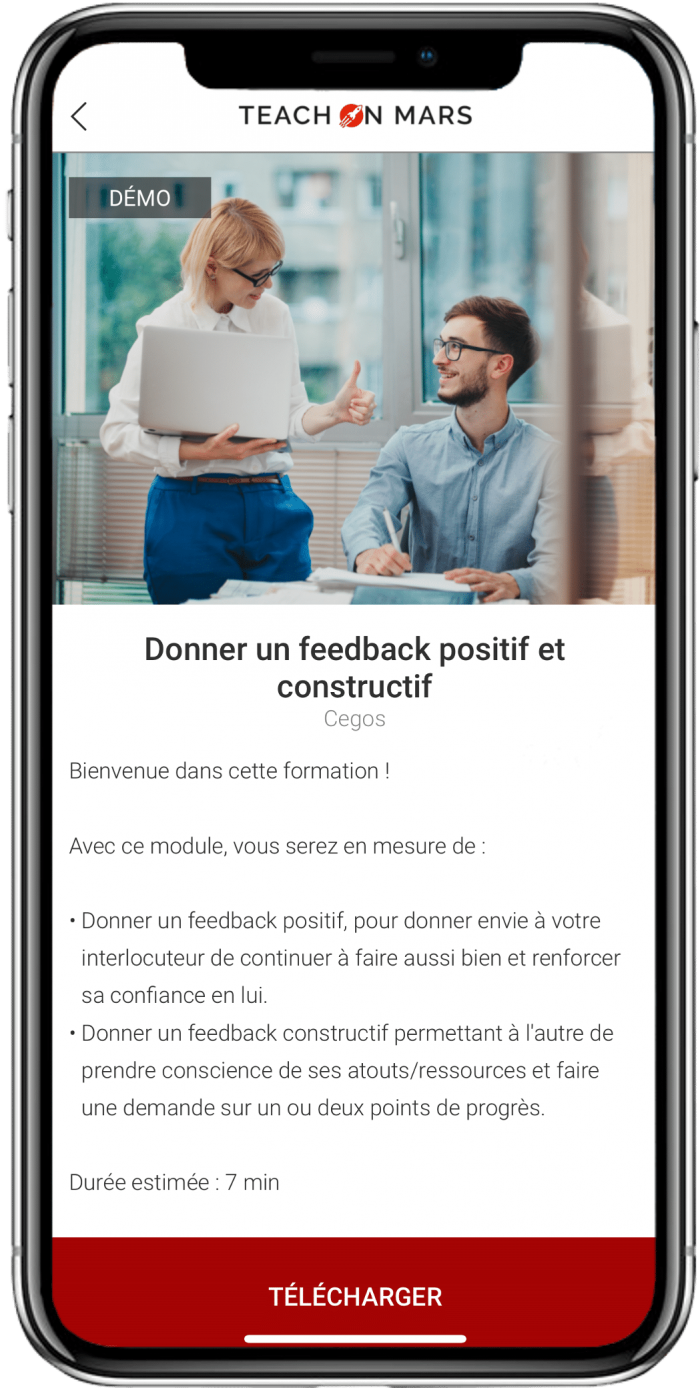
4. Mobile learning: more amusing and social thanks to its many educational tools
Neuroscience dedicated to learning
Neuroscience is a broad category of scientific disciplines which study anatomy, the way the nervous system works, the brain’s mechanisms and human behaviour.
Over the last few years, it has had particular resonance in the world of training, which uses the latest scientific discoveries to propose new and more effective teaching methods.
Neuroscience has demonstrated in particular the importance of digital tools in learning. They are also a formidable tool when used in conjunction with classroom training: what’s known as blended learning.
The use of active methods, such as role playing and serious games, encourages for example the transmission of glucose to the brain’s nerve cells, which promotes the assimilation of knowledge.
By offering varied activities, you can also offer more rhythm and boost interest in training. As a result, learners’ attention is significantly higher. Scientific research has emphasised the effectiveness of multi-sensorial methods which involve stimulating several senses to enhance memorisation. Diversity in pedagogical tools is therefore essential.
What’s more, the key role of repetition for the purposes of memorisation has been proven. Indeed, for information to be truly absorbed by the brain and to shift from a conscious to a sub-conscious state, training is required. Furthermore, several weeks are needed in order for a new habit to be fully acquired. Mlearning platforms facilitate this regular repetition as they are accessible anywhere, anytime.
Mobile learning is based in particular upon the 4 pillars of learning as defined by neuroscience:
Attention
Learners must focus on training and be shielded from any potential distraction.
Active engagement
Employees must actively learn, by putting into practice their knowledge and by testing what they have learned themselves.
Feedback
Learners are entitled to make mistakes and benefit from customised courses to focus on the skills they are lacking.
Consolidation
Activities and modules are proposed regularly to enhance recall.
The pedagogical tools of mobile learning
Directly inspired by the latest scientific discoveries, mobile learning deploys a large array of tools enabling learning to be accelerated, memorisation to be enhanced and learner engagement to be increased.
Gamification
Gamification involves adding elements of play in order to practice the theoretical aspects of training. This can take multiple forms: points systems, rewards, competitions, games of chance, etc.
Training can even become a game in its own right. Serious games, for example, immerse learners in company or profession-specific situations.
Gamification is based on the concept of positive reinforcement: by rewarding learners and motivating them, their memory skills increase dramatically.
Microlearning
Microlearning is a teaching method which uses short training sessions focusing on a specific objective.
Spacing between the various modules and repetition of information helps the brain to transfer it to long-term memory. In this way, knowledge is fully absorbed and can be located again easily by learners.
As part of onboarding, for example, microlearning allows a new employee’s first week to be split into several parts, so that they gradually familiarise themselves with the company culture and values, as well as the challenges associated with their job.
Flipped learning
Flipped learning involves, as its name would suggest, flipping the order of learning activities. Unlike the traditional teaching model, it allows individuals to learn theoretical concepts at home and to put them into practice later in class.
This teaching method enables you not only to customise training – each participant can learn remotely and at their own pace – but also to foster learner autonomy.
With mlearning, trainers can send content to learners prior to synchronous training sessions. During the session, they answer learners’ questions and build practical application activities with them.
Social learning
Social learning is a teaching method based on interactions within the learner group. The aim being to encourage learners to interact, discuss and share information and lesson material.
Psychologists have identified the importance of observation and imitation in the framework of learning. The behaviour, emotions and attitudes of each member of the group thus contribute to comprehensively improving the course.
With peer-to-peer learning, which aims to nurture an in-house culture of knowledge sharing, learners become actively involved with their training, by using their collective intelligence to solve problems or to answer questions.
For example, you can provide employees with a news feed (like on social networks) where they can share information and good practices.
Blended learning
Blended learning is a hybrid approach which combines classroom training and remote training. Learners alternate between short modules done using their mobiles and sessions with a trainer.
Generally teamed up with flipped learning, it enables each learner to acquire skills at their own pace, whenever they so wish and whenever they have time.
In parallel, learners can put their knowledge into practice and seek clarification or additional information during the classroom training sessions.
Want to learn more about the Teach on Mars platform user experience?
5. Developments in mobile learning: towards “in the flow of work” training
To increase learner engagement rates, it is primordial to provide them with high-quality content which fits their needs. After having rediscovered that courses centred around users were more efficient, it comes as no surprise then that the market is moving towards developing technologies which offer ever more customisation.
However, mobile learning is distinguished above all by its “in the flow of work” approach. In other words, it aims to offer continuous training, provided at the right time and in the right place.

Technology dedicated to content customisation

Whenever they follow or complete an m-learning training module, learners generate a great deal of data. Their course, progression, and the results of their assessments are systematically recorded. Analysing this valuable data is key to improving and customising training courses.
For example, by studying the content most consulted by learners, you can find out what they like and encourage them to consume more training modules. This approach also allows you to foster loyalty, while boosting professional and personal development.
Furthermore, analysing subject areas already covered by learners, enables you to suggest similar content (possibly of a higher level), so they develop their knowledge in a specific field.
Adaptive learning therefore exploits all of the possibilities offered by artificial intelligence (AI), to provide learners with content which is in line with their skills, desires and preferences. All of this, while helping them to achieve specific pedagogical aims.
Curiosity, an exclusive piece of technology developed by Teach on Mars, now enables you to harness the power of customisation, with recommendations of bespoke content and dynamic skills bases.
Analysing data allows you to assess in concrete terms the impact of courses on the company’s operating results. For example, data generated by learners can be cross-checked against sales or production data.
These learning analytics can be visualised easily using automated dashboards which are constantly updated thanks to artificial intelligence. In this way, the data is also in line with the company’s training profitability criteria.
Towards seamless training
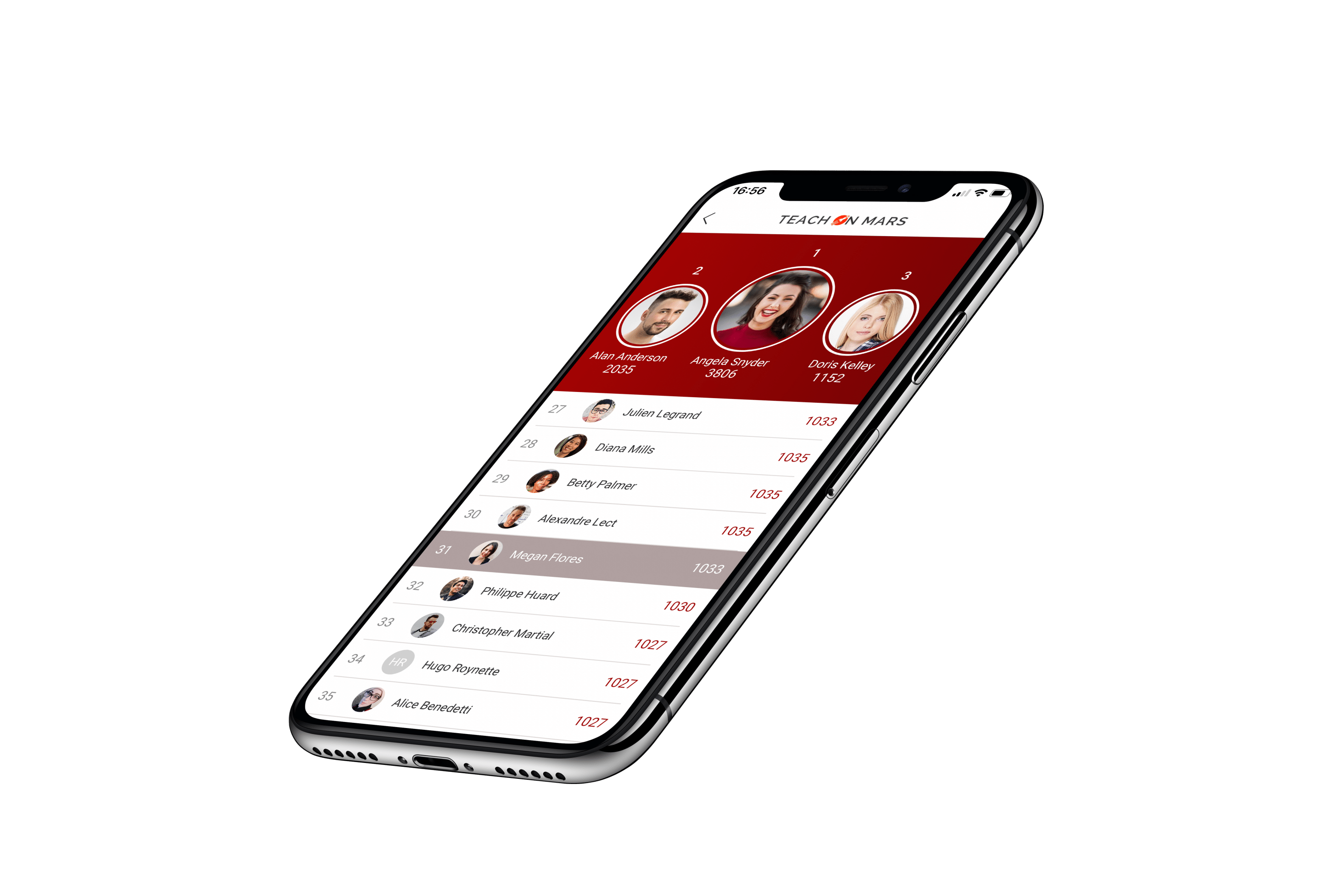
In some way, seamless learning constitutes the ultimate goal of all training systems. It involves offering learners a seamless learning experience, by alternating different teaching methods in a seamless manner.
Unlike blended learning, it does not only involve combining classroom training with remote training. Seamless learning offers a fully flexible and customised course, in which learners may begin to learn in a classroom, prior to continuing their course on their smartphone. All of this with seamless transition between modules.
What’s more, “in the flow of work” learning is not limited to smartphones. It can also be used with everyday professional tools, such as CRM or a platform for collaborative communication such as Slack or Microsoft Teams.
It is also possible to consider more innovative applications, such as augmented reality tools. In the framework of onboarding for example, learners can go on virtual tours to discover their professional environment, be it a shop, a production site, a laboratory, etc.
This approach, known as immersive learning, enables you to immerse learners in a virtual universe. It is perfect for all sorts of role play situations. Augmented reality also boasts a fun aspect, thus consolidating its impact.
Putting people back at the centre of training
Finally, the pedagogical engineering of tomorrow will assign a very important place to “re-humanising” training. In a more and more digitised world, classroom training is still a vital ingredient for successful learning: blended learning still has a bright future.
But digital technology can also help to bring more human elements to training, through the development of Visio conferences and live chats. The next step in this development is, without a doubt, individual mobile coaching, creating a special bond between learners and their personal coach.
This could take on a variety of forms, such as discussion via chats between the coach and learner, or short videos sent to take stock of learner progress. Mobile coaching will also include setting individual goals, which will need to be verified regularly by the coach.
E-learning, a strategic challenge for managing company talent
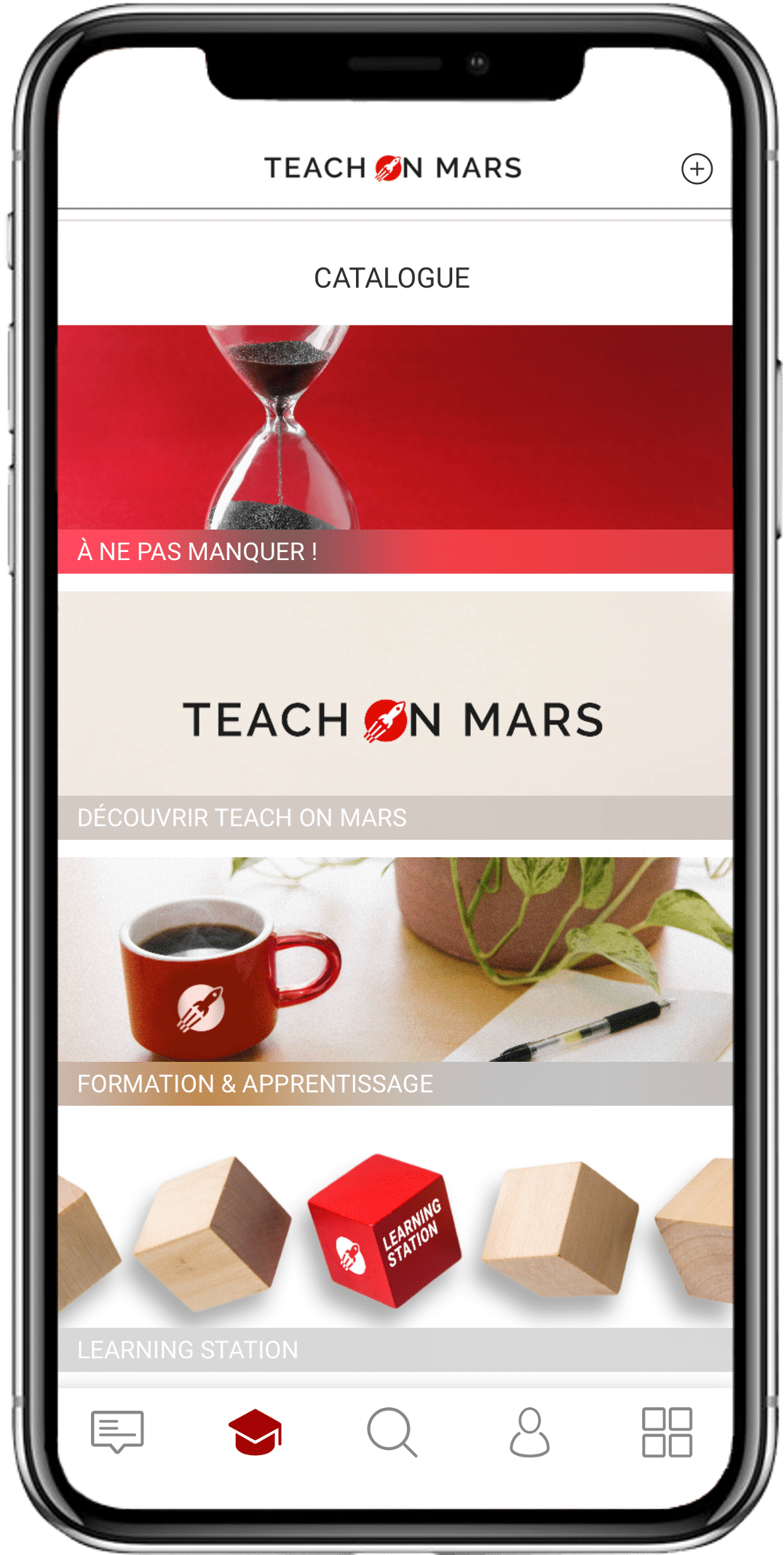
85% of the jobs of 2030 do not yet exist. In a climate of uncertainty, in which jobs are changing at an unprecedented speed, continuous training has become a real priority for businesses. They are also confronted with new regulatory constraints, which force them to constantly rethink their approach to training.
The stakes are high: it is no longer simply about training, but also developing a real learning culture to constantly adapt to market developments. From artificial intelligence to Big Data and robotics, new technologies are bringing to light unprecedented needs in terms of skills.
But beyond technical know-how, cross-functional skills and knowledge occupy an increasingly important place. Relational ease, team work, communication and flexibility are now essential qualities. Learning companies must place the same emphasis on soft skills as they do hard skills.
In parallel, the labour market is struck by an unprecedented talent shortage. The phenomenon is set to become increasingly acute. According to Korn Ferry, there will be a shortage of 1.5 million highly qualified professionals in France by 2030. Representing a loss of profit of more than 200 billion dollars.
And this is not simply a pessimistic forecast: the talent war has already begun. While the labour market is becoming increasingly competitive, training is establishing itself as a way to attract people and to retain the best people.
To address these challenges, e-learning and mlearning are vital solutions. Particularly flexible, digital tools allow you to quickly deploy relevant courses in line with emerging needs. In this way, you can constantly adapt to technological developments and ensure the sustainability of jobs.
What’s more, digital learning enables you to offer each individual a course which best matches their needs, for an optimal learning experience. Learning companies thus demonstrate their desire to support each employee by offering them genuine prospects for development. An attractive feature to appeal to the best talent!
6. The e-learning market: continued growth
%
The annual growth rate of the world education technology market. [1]
%
The percentage of companies using digital technology to train employees. [2]
%
The percentage of companies who wish to use digital learning to enhance the pedagogical effectiveness of their courses. [3]
%
The percentage of companies who wish to shift towards blended learning in the future. [3]
Key points:
Driven by strong growth, digital learning is gradually reaching maturity.
The digitisation of training has changed considerably since the first MOOCs: e-learning and mobile learning courses are now widely used by companies.
Companies are also using digital technology to enhance the attractivity and engagement rates of their courses. They have recognised the potential of mlearning and its innovative teaching methods to offer optimised courses which are in line with the aims, context and profile of each learner.
Need support to deploy your mobile learning strategy?
7. Case studies: companies which have revolutionised their training through mobile learning
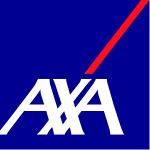
Creating a learning community thanks to gamification
International insurance group, AXA, integrated the Teach on Mars mobile learning platform to deploy attractive and gamified training resources on a number of subjects, including Big Data and AI.
27,000 users worldwide were able to take part in a 30-day challenge with a particularly high engagement rate, reaching a record number of 40,000 simultaneous pedagogical challenges. In total, nearly 780,000 challenges were launched, with a concrete impact on learners’ skills development.

Deploying an international training programme to standardise the client point-of-sale experience
Rimowa, a German high-end luggage company, deployed an mlearning training system for its sales force with a view to enhancing and standardising the client experience in-store.
In less than 4 months, the company deployed a large-scale training catalogue for a multi-lingual population of over 700 employees. Thanks to an optimal learning experience, engagement was enhanced considerably among sales teams and managers, with an adoption rate of 60% quickly being achieved in the brand’s points-of-sale.
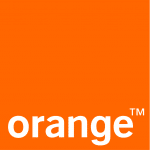
Digitising points of sale training
Operator, Orange, called on Teach on Mars to come up with a new, digital and flexible point- of-sale training model. The aim being to quickly and effectively train sales teams, who must constantly update their skills in the area of telephony.
Launched simultaneously in almost 200 stores, the mobile solution recorded an unexpected participation rate of 95% thanks to its attractive and gamified learning experience, with a measurable effect on sales performance. What’s more, the skills implementation timeframe for new hires in-store was slashed by half.
Conclusion
Mobile-learning is the culmination of several decades of developments in the world of training. From the initial e-learning modules to seamless and customised learning, significant strides have been made. However, although the sector is gradually reaching maturity, it is nonetheless driven by significant technological innovations which bring about rapid changes.
Mobile learning training is therefore a specialty in its own right, developed over the years thanks to a genuine capacity for innovation. Hence the importance of selecting an mlearning solutions provider with the know-how and agility required to address future challenges linked to the world of training.
Teach on Mars offers a digital training experience which boasts innovative features designed to boost learner engagement and power change within companies. Based on discoveries in neuroscience, our applications enable your employees to delve into a training course which is fully customised, emphasising your company culture in order to foster integration.

